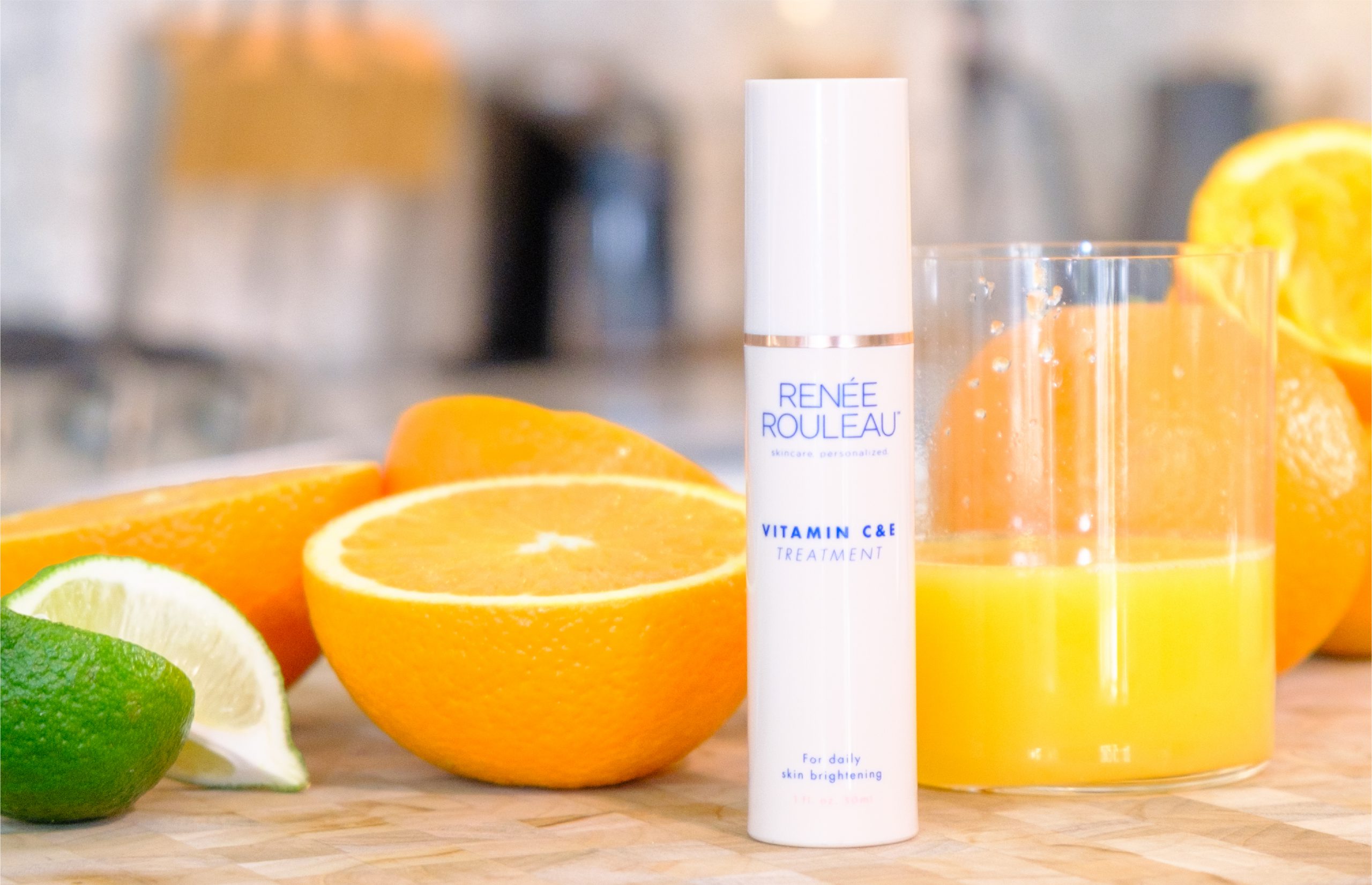
Adding a topical vitamin C serum to your skincare routine may be a no-brainer, but choosing the right one is a little more complicated. If you’ve ever spent time browsing vitamin C serums online, you’ve probably noticed the ingredient label never just reads “vitamin C.” There are many different forms of vitamin C used in skin care, and which one you choose definitely matters.
In this post, I’ll explain the critical role vitamin C plays in healthy skin aging and give you a guide to some of the most common forms of vitamin C in skin care. Let’s dive in!
What Are the Benefits of Vitamin C for Skin?
Like all vitamins, vitamin C can’t be produced by our bodies. Instead, it’s something we have to get from external sources such as food or supplements. Most of us get enough vitamin C through our diet, and severe deficiency is very uncommon. That said, since it’s needed for so many functions throughout the body, only a small percentage of the vitamin C we ingest will make it to our skin. This is why “supplementing” with a topical product is a great way to ensure your skin is reaping all the amazing benefits vitamin C has to offer.
So, how exactly does topical vitamin C benefit our skin? There are three main ways:
1. Vitamin C protects skin cells from environmental damage.
This probably isn’t news to you, but vitamin C is a potent antioxidant. It scavenges free radicals, which are unstable molecules that lead to skin damage and accelerate skin aging. Free radicals are constantly coming at us from so many different sources, including UV light from the sun, ozone, smoke, and pollution (to name a few). All of these are also responsible for a natural depletion of vitamin C in our skin over time, which is why supplementing with a topical antioxidant product is so important.
Also, check out this amazing visual demonstration I did of how vitamin C slows down oxidation from free radical damage!
2. Vitamin C helps prevent collagen breakdown and promotes healthier collagen production.
When we talk about “anti-aging” in skin care, it’s often in reference to an ingredient’s ability to stimulate collagen. This is no surprise considering collagen plays such a key role in keeping skin looking youthful. In fact, after age 20, our skin’s ability to replenish collagen decreases by about 1%-1.5% each year! Enter: vitamin C. First, it helps protect the collagen you already have by inhibiting a group of enzymes that break down collagen. Second, it aids in healthier collagen production since it’s a cofactor for two enzymes needed to build and cross-link collagen.
3. Vitamin C helps even out pigmentation for brighter-looking skin.
Of all its benefits, vitamin C may be best-known for its ability to create brighter more even-toned skin by fading blotchy hyperpigmentation. It does this by interrupting the over-production of melanin, which causes hyperpigmentation. It’s a great tool for managing hyperpigmentation disorders such as melasma.
What Is the Best Form of Vitamin C in Skin Care?
When it comes to vitamin C in skin care, there are two categories: active and inactive. The only active form is L-ascorbic acid, which is the bioavailable form of vitamin C (meaning the form our skin is able to use). All other forms of vitamin C are considered inactive because they have to be converted to L-ascorbic acid within the skin before they can get to work.
Inactive forms of vitamin C are still built on the foundation of L-ascorbic acid but have been modified to the point where they’re considered different molecules. These modified variations can either be an ester form of vitamin C, or they can be a different compound entirely where other components are added to stabilize the ascorbyl group. You’ll notice that all the inactive forms I talk about have “ascorb” somewhere in the name, which is how you know it’s a type of vitamin C (this can be handy to know when reading ingredient labels).
As I said, there are tons of different forms of vitamin C used in skin care, so I’ll just be covering four of the most common ones.
L-ascorbic Acid
As I mentioned earlier, L-ascorbic acid is the active, bioavailable form of vitamin C. This is what our cells use to carry out any and all functions that require vitamin C. Because of this, L-ascorbic acid has been researched more thoroughly than any other type of vitamin C in skin care. It’s been proven beyond a shadow of a doubt to work well as an antioxidant. We also know it’s effective for both collagen synthesis and evening-out hyperpigmentation.
If you opt for L-ascorbic acid, look for a serum that contains between 8% and 20%. This is the range in which studies have shown it to be most effective. Your skin only takes in as much vitamin C as it needs, so going above 20% won’t work any better and just increases the potential for irritation.
The problem with L-ascorbic acid
So if L-ascorbic acid is so tried and true, why even entertain other forms of vitamin C? The problem with L-ascorbic acid is that it only works effectively IF you’re able to get it into the skin, and therein lies the challenge. Pure ascorbic acid is incredibly unstable and since it’s an antioxidant, it wants to react with almost everything in its environment. This includes light, heat, oxygen, water, and metals. This means the ascorbic acid in your serum has a high chance of oxidizing before it gets a chance to make it into your skin. (Ever heard of vitamin C serums turning brown? This is why.)
One way brands and formulators combat this oxidation is by adding other molecules such as vitamin E or ferulic acid to their vitamin C serums. Both are proven to help stabilize ascorbic acid and to make vitamin C more effective. Still, you have to use up any serums containing L-ascorbic acid pretty quickly, or they can go bad. A good friend of mine who is a cosmetic chemist told me she avoids formulating with L-ascorbic acid as much as she can since it’s so difficult and unpredictable to stabilize.
In addition to stability issues, L-ascorbic acid has a high potential for irritation. It has to be at quite a low pH to remain stable, so this can cause skin irritation (especially if you use products with ingredients such as retinol or exfoliating acids). This makes it a bad fit for sensitive skin types, and it also isn’t recommended if you struggle with acne.
Sodium Ascorbyl Phosphate
Next up is our first inactive form of vitamin C, sodium ascorbyl phosphate. This vitamin C derivative is definitely more stable than L-ascorbic acid but can still be quite reactive. For this reason, it’s often used in skin care formulas as an encapsulation. Essentially what this means is that the ingredient is put into a protective shell to help it remain stable while getting where it needs to go, aka into your skin.
Manufacturer studies claim sodium ascorbyl phosphate offers the same benefits as pure L-ascorbic acid, especially when it comes to skin brightening and collagen synthesis. The key is making sure it’s stable within the formula and that it’s able to effectively penetrate into the skin.
One thing that’s unique about this type of vitamin C is that it’s been shown in studies to help improve acne. If you get breakouts and have previously struggled to incorporate vitamin C into your routine, this ingredient could be worth a shot! Just remember, acne is complex and will always require a targeted routine for your skin type.
Ascorbyl Methylsilanol Pectinate
This one is a bit of a tongue twister, and that’s because it’s actually a complex blend of many compounds rather than just a straightforward vitamin C derivative. Also inactive, this form of vitamin C is a great example of additional components being added as a means of stabilizing the more volatile ascorbyl group.
In this case, the stability of vitamin C is greatly increased by the addition of silanol. The silanol also aids in skin penetration, meaning this vitamin C compound has improved delivery into the skin. Finally, silanol has been shown to strengthen the membranes of skin cells, which makes them more resistant to attack by free radicals in the first place.
Tetrahexyldecyl Ascorbate
Last but not least, we have the inactive form tetrahexyldecyl ascorbate (THD). This one is my personal favorite and is also the superstar of my Vitamin C&E Treatment. What makes THD so different from the other types of vitamin C I’ve talked about is the fact that it’s an oil-soluble ester form of vitamin C.
Since THD is solubilized by oil instead of water, it won’t start to react and convert into L-ascorbic acid until it comes into contact with the oils in your skin. This makes it the most stable of all the forms of vitamin C I’ve mentioned so far. Another benefit of oil solubility is that it has a slower release time than water-soluble molecules. This means a longer window of active vitamin C in your skin, and therefore a longer window of protection.
The slow-release can also mean a lower potential for irritation than other forms of vitamin C. Also, since THD is oil-based, it doesn’t require a low pH the way water-soluble forms do. Again, this can mean less irritation.
Finally, one of the reasons I love this ingredient so much is that, aside from L-ascorbic acid, it has some of the most research behind it. One of the reasons it’s so highly studied is that it’s considered a quasi-drug in Japan thanks to its ability to improve skin pigmentation disorders. Pretty cool, right? What’s exciting to me about THD is that it’s actually been proven in studies to be comparable to L-ascorbic acid in terms of efficacy and results. It has a stellar track record when it comes to improving hyperpigmentation, and it may even improve collagen synthesis better than L-ascorbic acid.
To me, THD is the winner. The one downside is that it’s expensive to formulate with, which means it can be harder to find in skincare products than other, less expensive forms of vitamin C.
Learn to Spot Forms vs. Sources of Vitamin C
On a final note, I’d like to quickly touch on the issue of forms of vitamin C versus sources of vitamin C. All of the ingredients I’ve covered in this post are forms of vitamin C, meaning so long as they make it into your skin you’re guaranteed to be getting some amount of active ascorbic acid.
I’ve noticed some brands will sell products marketed as containing vitamin C, but you won’t actually find any form of vitamin C on the ingredient label. Instead, they’ll include extracts of plants or fruits known to be high in vitamin C. I’m not saying these ingredients are bad by any means (most of them have antioxidant properties and make great companions to vitamin C), but they’re not reliable sources of active vitamin C. There’s really no way to say for sure whether you’re actually getting any usable ascorbic acid from them.
Now that you know more about the best types of vitamin C, here are five qualities you should look for in an effective vitamin C serum.
Celebrity Esthetician & Skincare Expert
As an esthetician trained in cosmetic chemistry, Renée Rouleau has spent 30 years researching skin, educating her audience, and building an award-winning line of products. Her hands-on experience as an esthetician and trusted skin care expert has created a real-world solution — products that are formulated for nine different types of skin so your face will get exactly what it needs to look and feel its best. Trusted by celebrities, editors, bloggers, and skincare obsessives around the globe, her vast real-world knowledge and constant research are why Marie Claire calls her “the most passionate skin practitioner we know.”




